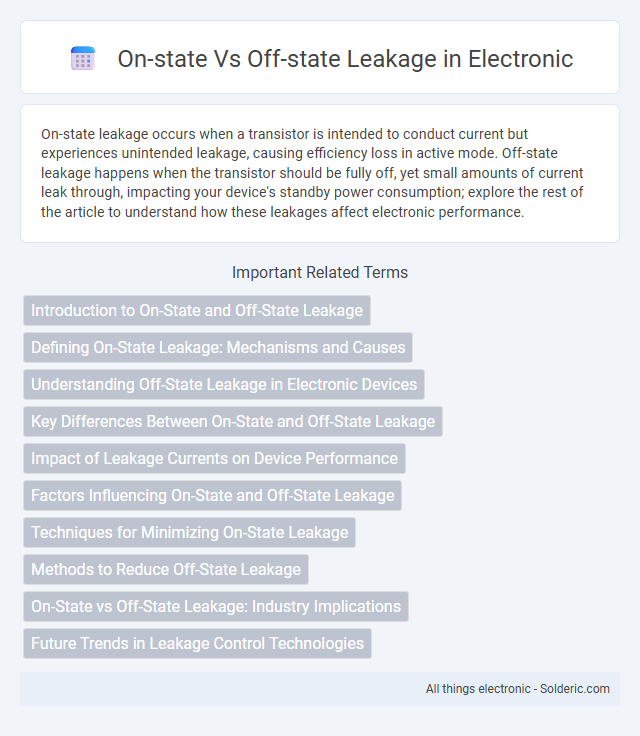On-state leakage occurs when a transistor is intended to conduct current but experiences unintended leakage, causing efficiency loss in active mode. Off-state leakage happens when the transistor should be fully off, yet small amounts of current leak through, impacting your device's standby power consumption; explore the rest of the article to understand how these leakages affect electronic performance.
Comparison Table
| Aspect | On-State Leakage | Off-State Leakage |
|---|---|---|
| Definition | Leakage current when transistor is conducting (ON) | Leakage current when transistor is non-conducting (OFF) |
| Magnitude | Generally lower, depends on channel resistance | Typically higher, caused by subthreshold, gate oxide, and junction leakages |
| Cause | Carrier flow through conducting channel | Subthreshold leakage, gate oxide tunneling, junction leakage |
| Impact | Power loss during active operation | Static power consumption when device is idle |
| Mitigation | Optimizing channel length, voltage scaling | High-k dielectrics, multi-threshold transistors, power gating |
| Significance in CMOS | Lower compared to off-state leakage | Major contributor to leakage power in deep submicron technologies |
Introduction to On-State and Off-State Leakage
On-state leakage refers to the unwanted current that flows through a transistor when it is intended to be in the conducting (on) state, causing power dissipation and reduced efficiency in integrated circuits. Off-state leakage occurs when a transistor is supposed to be non-conducting (off), yet a small leakage current still passes, contributing to static power consumption, especially in advanced CMOS technologies. Both leakage types are critical factors in semiconductor device design, impacting battery life in portable electronics and overall circuit reliability.
Defining On-State Leakage: Mechanisms and Causes
On-state leakage refers to the unintended current flow through a transistor when it is supposed to be conducting, primarily caused by short-channel effects and subthreshold conduction in advanced semiconductor devices. Mechanisms such as drain-induced barrier lowering (DIBL) and gate oxide tunneling contribute significantly to this leakage, impacting the device's power efficiency. Understanding these causes enables you to optimize transistor design for reduced power loss during active operation.
Understanding Off-State Leakage in Electronic Devices
Off-state leakage in electronic devices refers to the unwanted current that flows when a transistor is supposed to be off, contributing to power loss and reduced device efficiency. This leakage occurs due to various mechanisms such as subthreshold conduction, gate oxide tunneling, and junction leakage, which become more pronounced as device dimensions shrink in advanced semiconductor technologies. Minimizing off-state leakage is critical for low-power applications and extends battery life in portable electronics by reducing static power consumption.
Key Differences Between On-State and Off-State Leakage
On-state leakage occurs when a transistor is conducting current in its active state, resulting in a controlled and intentional flow of charge, whereas off-state leakage refers to unintended current that flows through the transistor even when it is supposed to be switched off. The magnitude of on-state leakage is significantly higher than off-state leakage, as off-state leakage is primarily caused by subthreshold conduction, gate oxide tunneling, and junction leakage, which are minimized but unavoidable in modern semiconductor devices. Understanding these key differences is crucial for optimizing your circuit's power consumption and improving overall device performance.
Impact of Leakage Currents on Device Performance
Leakage currents in both on-state and off-state critically affect semiconductor device performance by increasing power consumption and reducing operational efficiency. On-state leakage contributes to unwanted power dissipation during active device operation, while off-state leakage leads to significant standby power loss, which is crucial in low-power applications. Minimizing these leakage currents enhances device reliability, thermal stability, and extends battery life in portable electronics.
Factors Influencing On-State and Off-State Leakage
On-state and off-state leakage currents in semiconductor devices are influenced by multiple factors including device material properties, transistor size, threshold voltage, and operating temperature. On-state leakage primarily depends on channel resistance and carrier mobility, while off-state leakage is affected by subthreshold conduction, gate oxide thickness, and junction leakage. Understanding these factors helps you optimize device performance and power efficiency in integrated circuits.
Techniques for Minimizing On-State Leakage
Techniques for minimizing on-state leakage primarily involve optimizing transistor gate control to reduce leakage currents during conduction, such as using high-k dielectric materials to limit gate tunneling and employing multi-threshold CMOS (MTCMOS) design to balance performance and leakage. Advanced processes like strain engineering and channel doping modulation also help improve carrier mobility while suppressing leakage paths. Ensuring your device incorporates these methods can significantly enhance power efficiency without compromising operational speed.
Methods to Reduce Off-State Leakage
Techniques to reduce off-state leakage include using high-k dielectrics and metal gate materials to minimize gate leakage current, adopting multi-threshold CMOS (MTCMOS) designs to dynamically control transistor thresholds, and implementing power gating to completely shut off inactive circuit blocks. Device engineering approaches such as body biasing and channel doping optimization also effectively suppress subthreshold leakage. Material innovations like strained silicon and advanced FinFET architectures further enhance the leakage control by improving electrostatics in off-state conditions.
On-State vs Off-State Leakage: Industry Implications
On-state leakage refers to current flow when a transistor is actively conducting, while off-state leakage is the minimal current that leaks through when the transistor should be off. Off-state leakage poses significant challenges for power consumption and thermal management in semiconductor devices, impacting battery life and system reliability. Your design choices must balance minimizing off-state leakage to reduce standby power without compromising on-state performance, a critical factor in advanced integrated circuits and low-power electronics development.
Future Trends in Leakage Control Technologies
Future trends in leakage control technologies emphasize advanced materials such as high-k dielectrics and novel transistor architectures like FinFETs and gate-all-around FETs to reduce both on-state and off-state leakage currents. Researchers are also exploring adaptive body biasing and dynamic voltage scaling to optimize power efficiency while maintaining performance in nano-scale devices. Your electronic designs can benefit from these innovations by achieving lower power consumption and enhanced thermal management in next-generation integrated circuits.
On-state vs Off-state leakage Infographic

 solderic.com
solderic.com